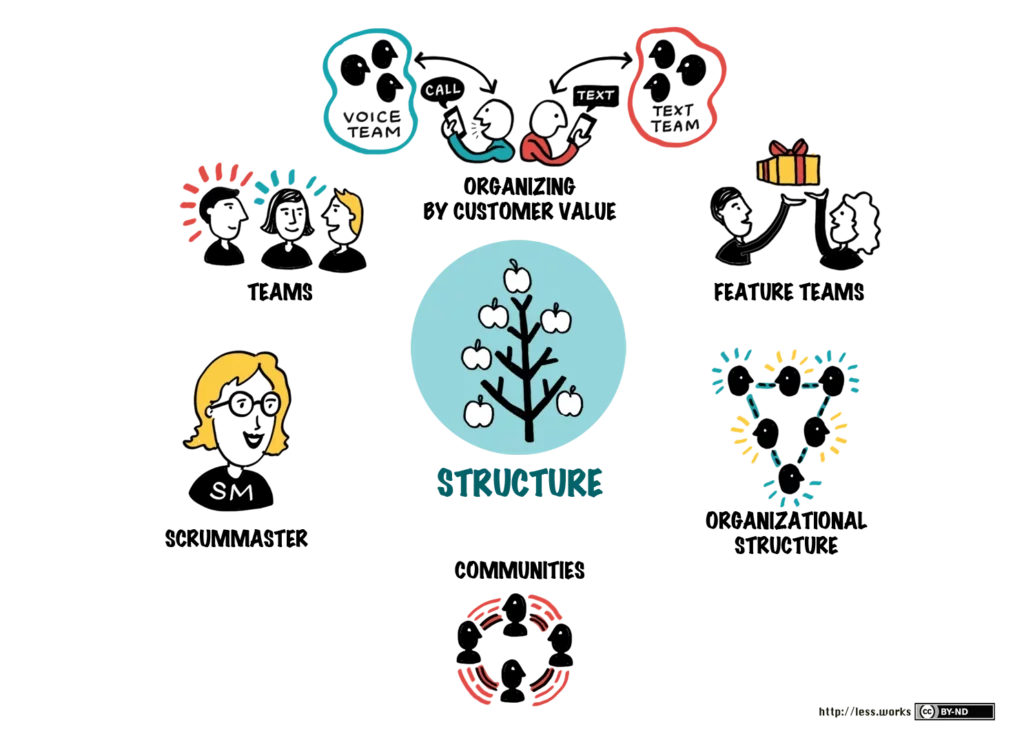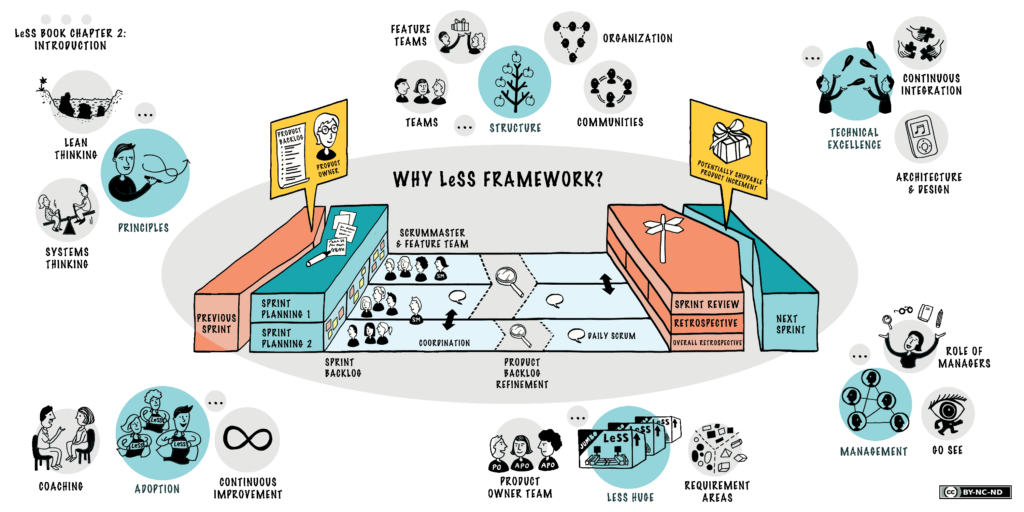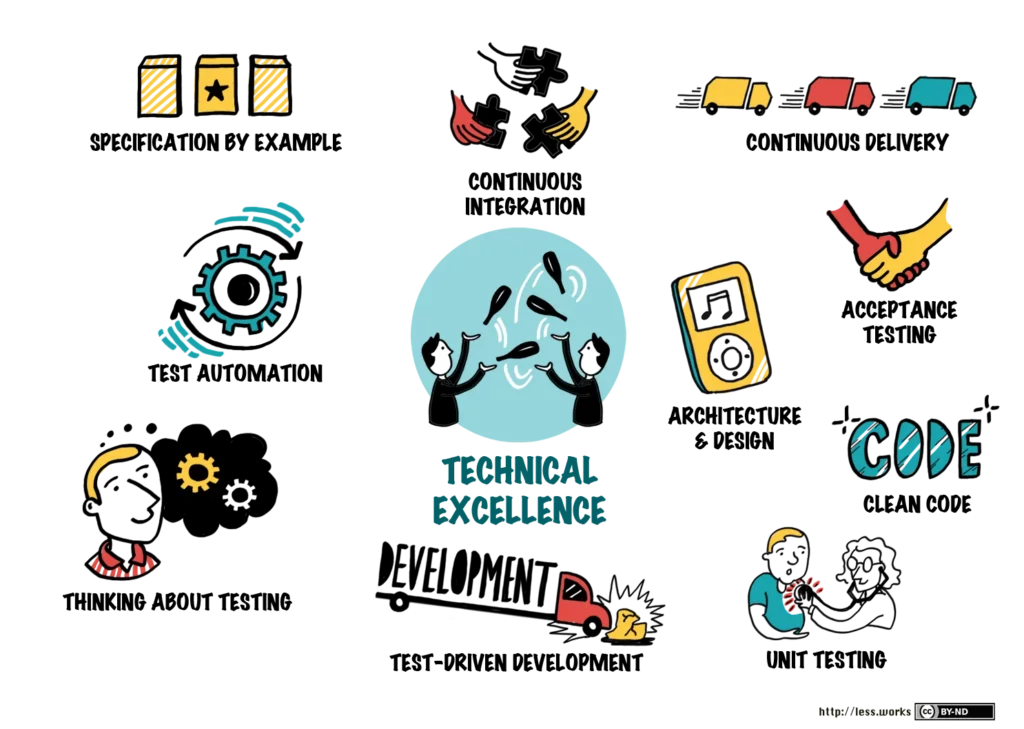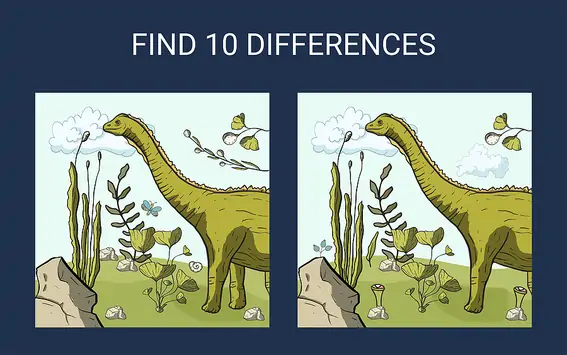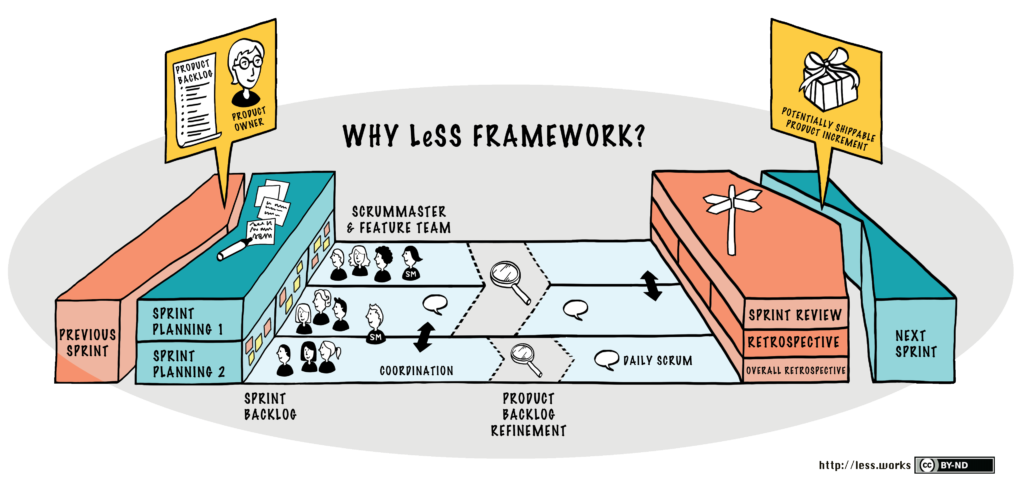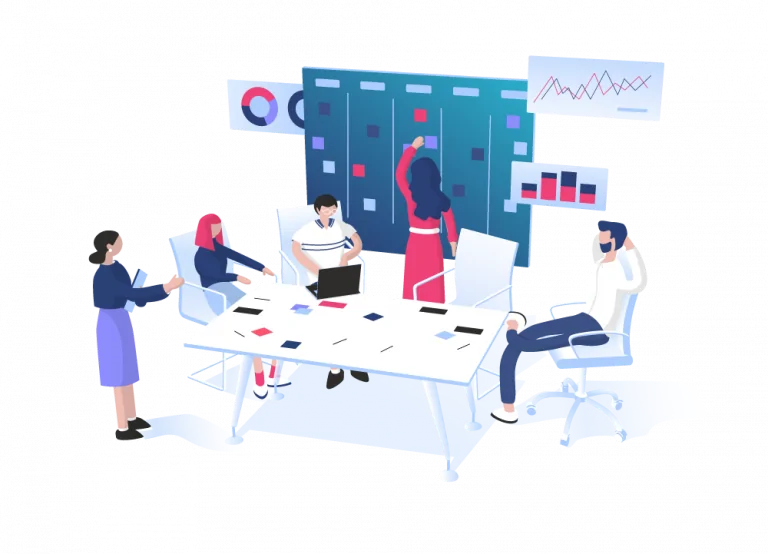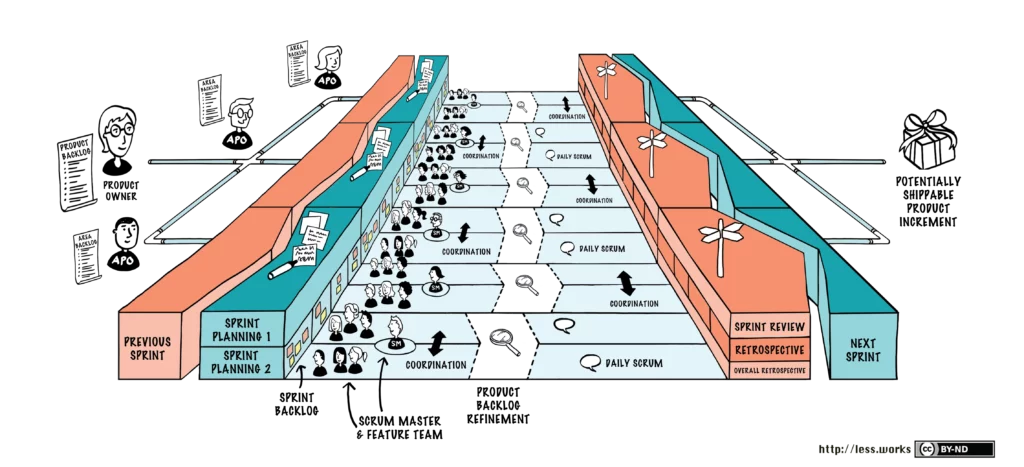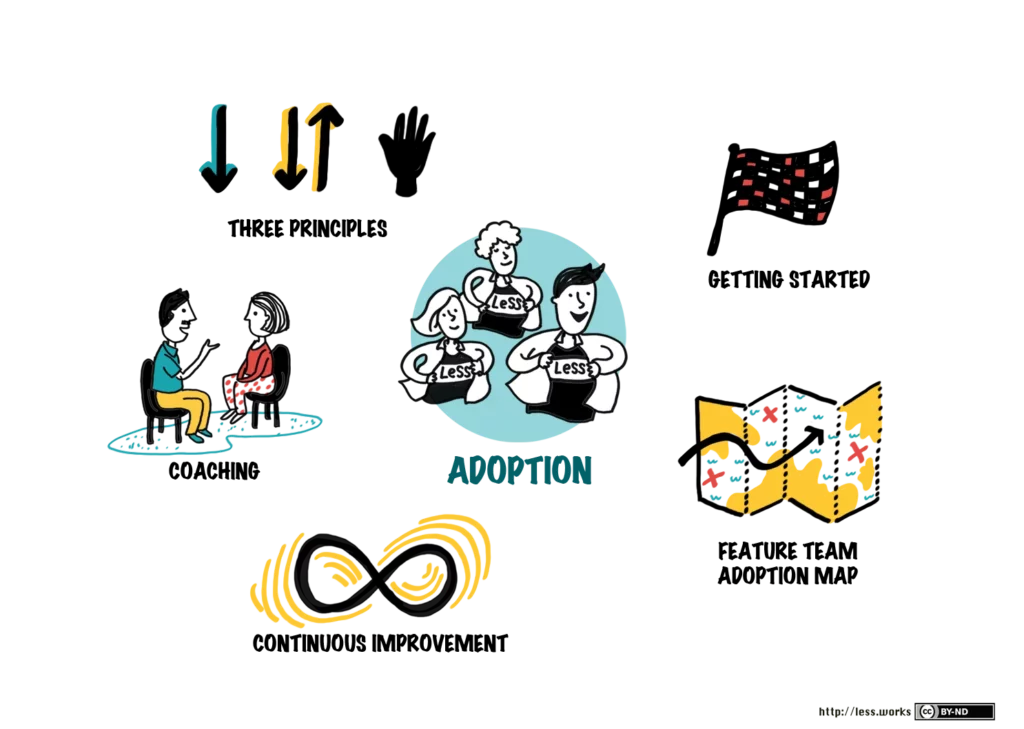Large Scale Scrum: Comprehensive Overview Of LeSS

Agile 101
Introduction to Large Scale Scrum (LeSS)
Let’s Start:
-
Brief Overview
-
Brief History
-
LeSS Rules
-
LeSS Principles
-
LeSS Practices
-
LeSS versus single-team Scrum
-
Planning and Budgeting
-
Coordination
-
Queueing Theory
-
Roles and Responsibilities
-
LeSS Huge
-
Organizational Structure
-
Key Meetings
-
Sprint Planning
-
Product Backlog Refinement
-
Retrospective
-
Common Pitfalls
-
Getting Started
Brief Overview
Large Scale Scrum, LeSS for short, is a scaled agile framework that guides you in adopting and applying agile at scale.
LeSS keeps Scrum’s core intact: exposing organizational design weaknesses through a minimal framework and letting you solve the complex problems inherent in development, through empirical process control and continuous improvement.
LeSS seeks to apply the “principles, purpose, elements, and elegance of Scrum in a large-scale context, as simply as possible.” Among other principles and practices, it uses Lean Thinking and Systems thinking to keep the framework and your overhead as light as possible and still guide you in important decisions.
In fact, Large Scale Scrum defines two frameworks:
-
LeSS lets you scale Scrum to up to eight teams of up to eight people each.
-
LeSS Huge helps you scale Scrum up to a few thousand people on a single product.
By picking the one that fits your size, you won’t burden yourself with unnecessary ballast.
To clear up any confusion: the word LeSS means both Large Scale Scrum in general and the framework for smaller organizations.
Brief History
Back in 2005, Craig Larman and Bas Vodde created Large Scale Scrum working together at Nokia Siemens Networks applying Agile and Scrum to very large and multisite product development.
Since then, product groups applying LeSS run the gamut in size, from as small as two teams to as large as 2500 people.
Principles, and Practices
Applying LeSS means:
-
Getting clear on the few rules it considers a must.
-
Following the guidance of its 10 Principles in making your decisions.
-
Structuring your product group according to its description of how to organize.
-
Following its description of Scrum Sprints in a large-scale context.
-
Applying the practices it defines for Technical Excellence.
-
Taking to heart what it has to say about adopting LeSS successfully.
-
Heeding what it has to say about coordination and management in a new reality.
Rules
For everything else you’re free to make your own decisions guided by the same principles that guided LeSS’ authors in its creation.
I won’t repeat the LeSS rules here, but I do advocate keeping them front and center at all times so they can be referred to often (they’re only two pages!).
Principles
LeSS can be lean in rules because of its ten principles to guide your decisions for everything it doesn’t consider essential (a must).
-
Large-Scale Scrum is Scrum
-
More with LeSS
-
Systems Thinking
-
Lean Thinking
-
Empirical Process Control
-
Transparency
-
Continuous Improvement Towards Perfection
-
Customer-Centric
-
Whole Product Focus
-
Queueing Theory
Principle 1: Large-Scale Scrum is Scrum
Principle 3: Systems Thinking
Principle 4: Lean Thinking
Principle 5: Empirical Process Control
Principle 6: Transparency
Principle 7: Continuous Improvement Towards Perfection
Continuous improvement toward perfection says three things:
-
“It’s okay not to be perfect right now.”
-
“Yet you want and need to continually strive to get there.”
-
“You need to be okay with never getting there because there’ll always be something else to improve.”
Principle 8: Customer Centric
Principle 9: Whole Product Focus
Principle 10: Queueing Theory
For example:
-
The portfolio of projects and products is a queue.
-
The product backlog is a queue.
-
The Sprint backlog is a queue.
-
Every status in a workflow is a queue where work waits to be picked up for the next step.
-
An overworked integration server is a queue.
-
Shared test environments are queues.
And there’s also a lot of inventory in those queues.
-
Finished design documents waiting to be implemented.
-
Any code not yet released, or kept from customers by feature flags, at varying stages of completion.
-
Feature branches are both inventory and a queue of sorts.
Practices
-
Continuous integration
-
Continuous delivery
-
Architecture & Design
-
Clean code
-
Unit testing
-
Test-Driven Development (TDD)
-
Thinking about testing
-
Test automation
-
Acceptance testing
-
Specification by example
Similarities and Differences
LeSS versus single-team Scrum
But there are differences.
The ones that LeSS itself reports:
-
LeSS Teams are what Scrum sees as the development team. Scrum’s Scrum team is not a concept in LeSS.
-
LeSS talks about self-managing rather than self-organizing teams.
-
LeSS sees the Scrum Master role as a dedicated full-time job. However, a Scrum Master can guide and coach up to three teams to see the larger product and production system.
-
LeSS doesn’t require the Product Owner to participate in every team’s Daily Scrum or Retrospective.
-
LeSS splits Sprint Planning in two parts.
-
LeSS expects Backlog Refinement to be a formal event (it’s an activity in Scrum).
-
LeSS doesn’t require Sprints to have a Sprint Goal, though it considers it a useful practice.
In addition:
-
The Product Owner is not required to attend each teams’ Product Backlog Refinement. Teams conduct the refinement with customers and users, freeing the Product Owner to do more forward looking work.
-
LeSS adds an overall Retrospective for all teams together.
-
LeSS specifically addresses what role managers can still play and how they can still add value even when their responsibilities are largely taken over by the Product Owner or delegated to the Teams.
-
Where Scrum says three to nine in a team or team of teams, LeSS recommends a maximum of eight. It’s based on observations during many LeSS adoptions.
Planning and Budgeting
Coordination
In other words:
-
Cross-team collaboration as needed on architecture, design, modeling, etc.
-
Use the source code as a fountain of knowledge about the product.
-
Use Open Space “technology” to share information, knowledge, and experience.
-
Promote cross-team interactions through observing each other’s Daily Scrums and simply sitting having one or more members sit with another team (Travelers).
-
Form self-organized Communities of Practice (CoP) of volunteers with a shared interest. Support the informal leaders, CoP coordinators, that naturally rise in the group because of their more than average interest in the topic.
-
Form self-organized Communities of Practice (CoP) of volunteers with a shared interest. Support the informal leaders, CoP coordinators, that naturally rise in the group because of their more than average interest in the topic.
Queueing Theory
Key Roles and Responsibilities
LeSS Huge
Organizational Structure
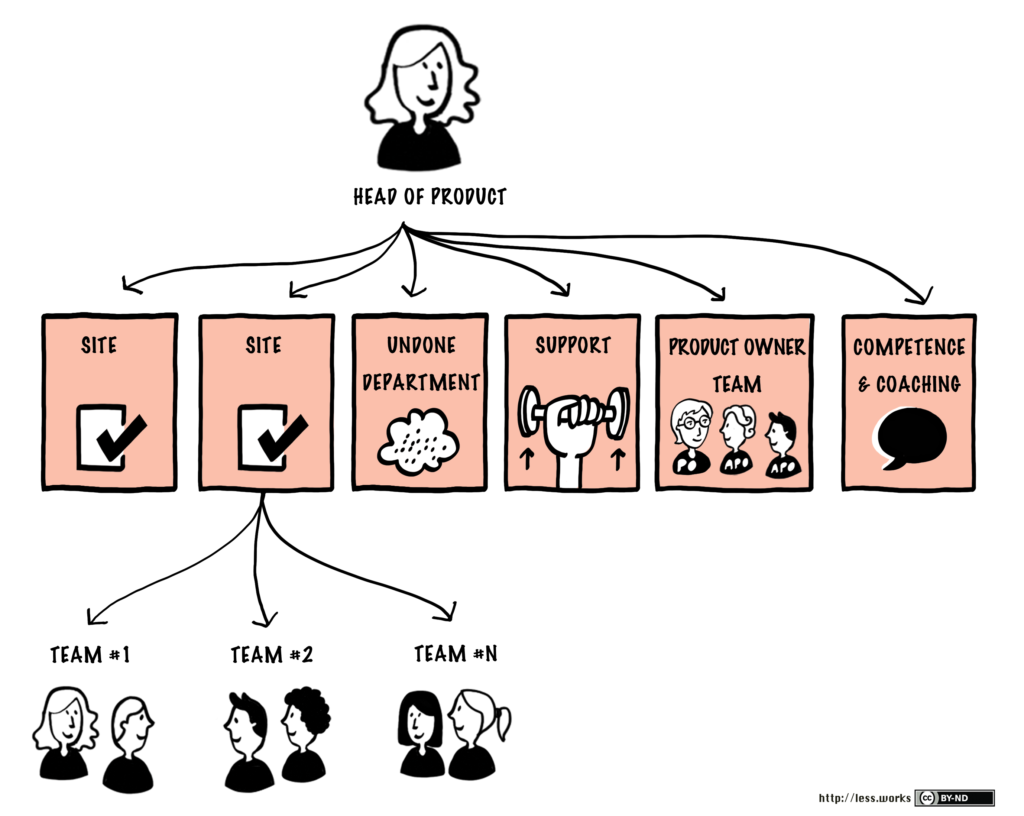
LeSS Huge
Key Meetings, Cycles, Delivery Cadences
Key Meetings, Cycles, Delivery Cadences
It’s split into two parts.
-
1. Sprint Planning One
-
2. Sprint Planning Two
Daily Scrum
Product Backlog Refinement (PBR)
Sprint Review
Retrospective
LeSS Huge
Methods and Techniques
Common Pitfalls
The biggest LeSS specific pitfalls are:
-
not embracing cross-team collaboration in architecture, design, and modeling and thereby not making options and solutions knowable and available across all teams.
-
not striving to dismantle the undone departments and keeping project managers and a Project Management Office around and thereby reducing clarity and likely facing energy-sapping and unproductive turf wars as nobody likes to lose parts of their kingdom.
-
not severing cross-functional team members’ reporting relationship with their former managers and thereby putting them in a situation of conflicting loyalties.
Getting Started
A few basics to put in place for a more successful adoption:
-
Get everyone on the same page in their knowledge and understanding of Scrum and LeSS. Invest in several days of training for everyone.
-
Get everyone on the same page about what whole product they’re all working on.
-
Use a strong Definition of Done (rather than a weak one that reflects current reality) and create cross-functional teams that can meet them by moving people (letting them volunteer!) from Undone Departments into them.
-
Make it clear that only the Product Owner can give teams work. You don’t want any team interrupted by and feeling any obligation to cater to seemingly reasonable requests by line manager, Sales, HR, or even the CEO.
-
Project Managers have no role in LeSS but may still be around while you get things in order. During that time, keep them as far away as possible from the teams, because they’re likely to interrupt and cause confusion on whether team members should still act upon what they say. See the previous point.
-
Project Managers have no role in LeSS but may still be around while you get things in order. During that time, keep them as far away as possible from the teams, because they’re likely to interrupt and cause confusion on whether team members should still act upon what they say. See the previous point.
Further Reading
-
Scaling Lean and Agile Development (2009)
-
Practices for Scaling Lean and Agile Development (2010)
-
Large-Scale Scrum: More with LeSS (2015)
Chapters from these books are available online:
-
Introduction to LeSS (Chapter 2 of LeSS book) — where you can find many details on the topics discussed (and not discussed) in this article.
-
Inspect & Adapt Chapter from Practices for Scaling
-
Agile Contracts
-
Design and Architecture
-
Lean Thinking
-
Feature Teams
The Agile Alliance has a very interesting article on LeSS without Scrum. It tells of an approach to adopting LeSS’ organization design first and only then introducing Scrum.
Are You Ready to Do More With LeSS?
Check out Nimble Now!
Humanize Work. And be Nimble!

